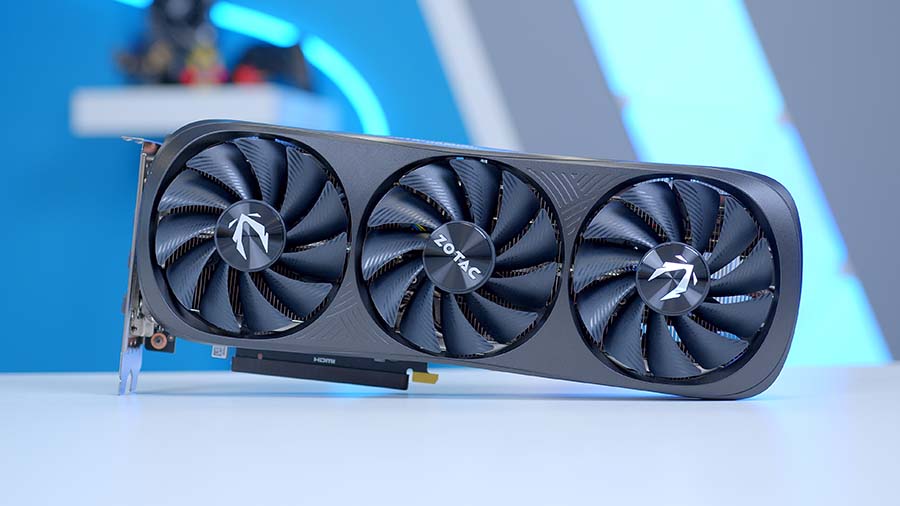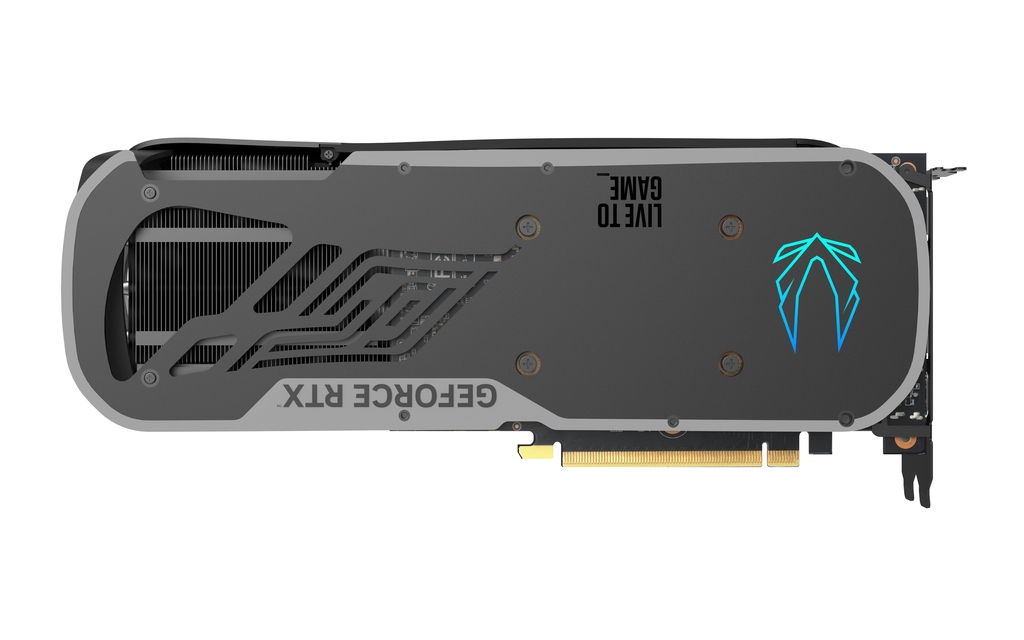Cons
- Increased power consumption
- Too pricey compared to AMD’s competitor
Zotac GeForce RTX 4070 Ti Super Trinity Black Edition Specs
| Graphics Processor |
Nvidia AD103 |
| GPU Base Clock |
2340 MHz |
| GPU Boost Clock |
2610 MHz |
| Graphics Memory Type |
GDDR6X |
| Graphics Memory Amount |
16 GB |
| HDMI Outputs |
1 |
| DisplayPort Outputs |
3 |
| VirtualLink Outputs |
|
| Number of Fans |
3 |
| Card Width |
double |
| Card Length |
12.1 inches |
| Board Power or TDP |
285 watts |
| Power Connector(s) |
12VHPWR |
The introduction of a newer and faster graphics card at the same price point as its predecessor is generally welcomed. The Nvidia GeForce RTX 4070 Ti Super exemplifies this scenario, outperforming the original RTX 4070 Ti. However, the excitement surrounding its release is somewhat muted, particularly in light of recent price reductions on rival AMD products. The specific model evaluated, Zotac’s GeForce RTX 4070 Ti Super Trinity Black Edition, is a robust card featuring 16GB of GDDR6X memory. While it is commendable at its introductory, it does not offer sufficient advantages over the non-Super variant to deter consumers from seeking deals on the previous model.
Design: The RTX 4070 Ti Enhances Performance
Among Nvidia’s newly introduced RTX 40-series Super graphics cards, the GeForce RTX 4070 Ti Super stands out due to its notable enhancements compared to its predecessor. While the RTX 4070 Super utilizes the same “Ada Lovelace” AD104 architecture as the original RTX 4070, it boasts a 22% increase in core count. Additionally, the RTX 4080 Super retains the AD103 GPU die, featuring a greater number of active cores and improved RAM speed.

In contrast, the original RTX 4070 Ti utilized the AD104 GPU die, whereas the GeForce RTX 4070 Ti Super is constructed on the AD103 die, which is also employed in the RTX 4080. Given that the non-Super variant was already operating with a fully enabled AD104 die featuring all 7,680 cores active, transitioning to the AD103 allows Nvidia to enhance the card’s core count to 8,448.
While the increase is approximately 9%, it is accompanied by notable enhancements in the memory subsystem. The RTX 4070 Ti Super benefits from an improved memory bandwidth due to the expanded 256-bit memory interface of the AD103 GPU. Although the GPU clock has seen a minor adjustment (a modest increase of 30Hz on the base clock) and the memory clock remains unchanged, the specifications suggest that the GeForce RTX 4070 Ti Super represents a significant advancement over its standard counterpart.
Utilizing the Zotac GeForce RTX 4070 Ti Super Trinity Black Edition.
In contrast to the RTX 4070 Super, Nvidia decided against producing a Founders Edition card for the GeForce RTX 4070 Ti Super. As previously noted, our test sample was provided by Zotac, specifically the Zotac GeForce RTX 4070 Ti Super Trinity Black Edition. This model bears a resemblance to the Zotac GeForce RTX 4070 Ti that we evaluated last year, featuring an extensive triple-fan cooling system.

Zotac has engineered its cooling solution with two substantial aluminum heatsinks, which are equipped with multiple heat pipes to enhance the dissipation of heat from the GPU, RAM, and power components located on the surface of the graphics card. Additionally, the card features RGB LEDs positioned along its side and an aesthetically pleasing backplate that contributes to its durability.
The majority of the ports are standard, featuring one HDMI port and three DisplayPort connectors located on the rear I/O panel. The most notable exception is the 12VHPWR connector situated on the side of the card, which is utilized for its power supply.
This connection is technically standard; however, the industry has been relatively slow to embrace it, with Nvidia being the primary advocate. Given that most currently available power supplies do not accommodate this connector, Zotac provides an adapter with the graphics card that transforms two 8-pin PCIe power jacks into a 12VHPWR connection.
Configuration of the Test Environment
We conducted our benchmark evaluations on the new GPU utilizing our existing desktop testbed, which is equipped with an Intel Core i9-12900K processor mounted on an Asus ROG Maximus Z690 Hero motherboard, complemented by a Corsair Hydro Series H100X water cooling system. The CPU operates at its default clock speeds, supported by a 32GB Corsair Vengeance RAM kit running at 5,600MHz. Additionally, Corsair provided the storage and power components for this setup, including a Corsair MP600 Pro NVMe 4.0 solid-state drive and a Corsair HX1500i 1,500-watt 80 Plus Platinum power supply. All benchmarking was conducted on Windows 11 Pro with the most recent updates applied.
With the introduction of the GeForce RTX 4070 Ti Super as a successor to the original RTX 4070 Ti, it is essential to evaluate whether the new graphics card surpasses its predecessor across all benchmarks. The hardware enhancements of the new model should facilitate this comparison. However, competing with the AMD Radeon RX 7900 XT will prove to be more difficult, particularly in light of AMD’s recent price reduction of, bringing the cost down from new Nvidia offering. Unless the RTX 4070 Ti Super demonstrates significant performance improvements in multiple areas compared to the original, it will encounter considerable challenges in competing against AMD’s offerings.
Results of Synthetic Testing
While synthetic benchmarks are valuable tools in our arsenal, it is essential to interpret their results with caution, as they may not accurately reflect the genuine capabilities of the components.
The GeForce RTX 4070 Ti Super achieved a score approximately 10% greater in 3DMark compared to its predecessor. In contrast, Furmark presented a different outcome, indicating that the new card typically performed worse than the non-Super variant.
Evaluation of DLSS, FSR, and Ray-Tracing Technologies.
These evaluations provide the RTX 4070 Ti Super with an optimal opportunity to demonstrate its capabilities. The implementation of ray tracing considerably elevates the demands placed on graphics cards, making it more probable that the Super’s additional cores and enhanced bandwidth will yield noticeable benefits in this context compared to others.
Preliminary test outcomes from F1 22 indicated that the 10% performance lead claimed by 3DMark was largely substantiated. At a resolution of 1080p, the RTX 4070 Ti Super demonstrated a modest 6% increase in speed compared to its predecessor, with this advantage diminishing to a mere 4% at both 1440p and 4K resolutions. Both graphics cards significantly outperformed their primary rival, the Radeon RX 7900 XT, in this particular game. However, enabling DLSS and FSR altered the dynamics, resulting in the AMD card surpassing the Nvidia counterpart.
The GeForce RTX 4070 Ti Super demonstrated commendable performance in Returnal; however, similar to the majority of graphics cards I have evaluated thus far, it was advisable to disable frame generation and DLSS 3 for this particular game, as their activation negatively impacted performance. Additionally, the RTX 4070 Ti Super outperformed most of its competitors in Guardians of the Galaxy, although this title has historically favored Nvidia hardware in previous assessments.
Contemporary Video Games Lacking Ray-Tracing Technology.
Nvidia’s stronghold in games that utilize ray-tracing technology presents a significant challenge for AMD in terms of competition. Conversely, in titles that do not incorporate ray-tracing, Radeon graphics cards frequently outperform their counterparts.
Indeed, the Radeon RX 7900 XT demonstrated a significantly enhanced competitiveness against the new RTX 4070 Ti Super in this context. In Total War: Three Kingdoms, the AMD graphics card exhibited a 7% lead at 1080p and a 5% lead at 1440p, while both GPUs were evenly matched at 4K resolution. In Shadow of the Tomb Raider, the RX 7900 XT maintained a 6% performance advantage at 1080p; however, the two cards were tied at 1440p, with the GeForce GPU surpassing the RX 7900 XT by 4% at 4K resolution.
The RX 7900 XT once again took the top position in Far Cry 5; however, similar to the findings in Guardians of the Galaxy, it is prudent to approach these results with some skepticism. This particular game does not inherently favor AMD hardware, yet it tends to experience either a game-engine or processor bottleneck across most high-end graphics cards. Nevertheless, this limitation does not apply to our 4K test results, which indicated that the Radeon GPU outperformed the GeForce card by approximately 6%.
Legacy Game Assessments
The performance of older games is often influenced more by software drivers than by the hardware itself. Nevertheless, the results obtained from Bioshock Infinite were comparable to those from our other tests that do not utilize ray tracing.
The RTX 4070 Ti Super performed nearly on par with the RX 7900 XT at 4K resolution, although it exhibited slightly lower performance at reduced resolutions. In the game Hitman Absolution, both graphics cards demonstrated equal performance at 1440p, while the AMD card outperformed its competitor by approximately 17% at 1080p and by an even greater margin of 22% at 4K. Although the RTX 4070 Ti Super secured victories in a few benchmarks within Sleeping Dogs, it still lagged behind at 1080p.
Energy and Thermal Management
In specific benchmarks, I assess the overall power consumption of the graphics card test setup utilizing a Kill-A-Watt wall meter. Given that only the graphics card is altered between tests, the majority of the recorded variations should be attributed to the power consumption of the GPU.
The power consumption of the GeForce RTX 4070 Ti Super was rather underwhelming overall. In the game Guardians of the Galaxy, it utilized more power than the RTX 4080 and exhibited a 7% increase compared to the original RTX 4070 Ti. While its power draw in FurMark showed slight improvement, it remained considerably higher than that of its predecessor. This trend persisted in Returnal, where the Super model consumed 16% more power with DLSS activated than the standard RTX 4070 Ti.
The increase in power consumption is unlikely to concern the majority of gamers; however, it appears somewhat excessive when compared to the performance gains observed in our gaming benchmarks. On a positive note, Zotac’s thermal management system functioned effectively during the evaluations, ensuring that the graphics card did not surpass a temperature of 71 degrees Celsius.
Conclusion: Achieving Victory through Points, Suffering a Deficit in Price.
Should you be willing to accept a slight increase in power consumption, which is likely not a significant concern, the Nvidia GeForce RTX 4070 Ti Super significantly outperforms its predecessor in nearly every quantifiable aspect. Given that both graphics cards are available at the same, there is little justification for opting for the original RTX 4070 Ti, which may explain Nvidia’s decision to phase it out.
Nvidia has also made strides in enhancing its competitive edge. The GeForce RTX 4070 Ti consistently outperformed AMD’s Radeon RX 7900 XT in ray-tracing supported games, and this advantage has further expanded with the introduction of the RTX 4070 Ti Super. The activation of DLSS or FSR enhances performance for both AMD and Nvidia graphics cards; however, it generally provides a more substantial benefit to Radeon cards. This improvement was significant enough for the RX 7900 XT to surpass the RTX 4070 Ti Super in certain ray-tracing titles, such as F1 22, although the margin of victory was notably narrower compared to its performance against the original model.
The concluding statement may encapsulate the essence of the RTX 4070 Ti Super: while it is certainly more powerful than the standard 4070 Ti, it does not significantly alter the competitive dynamics. The Radeon RX 7900 XT continues to outperform it in most gaming scenarios that do not utilize ray-tracing, as well as in games that benefit from FSR and older titles. Although the advantage held by AMD has diminished, it remains largely intact in many instances.



